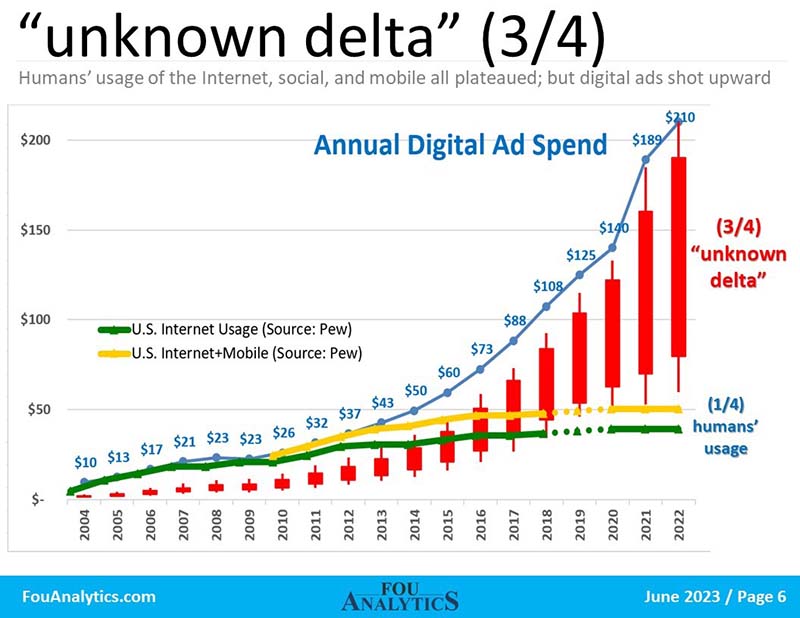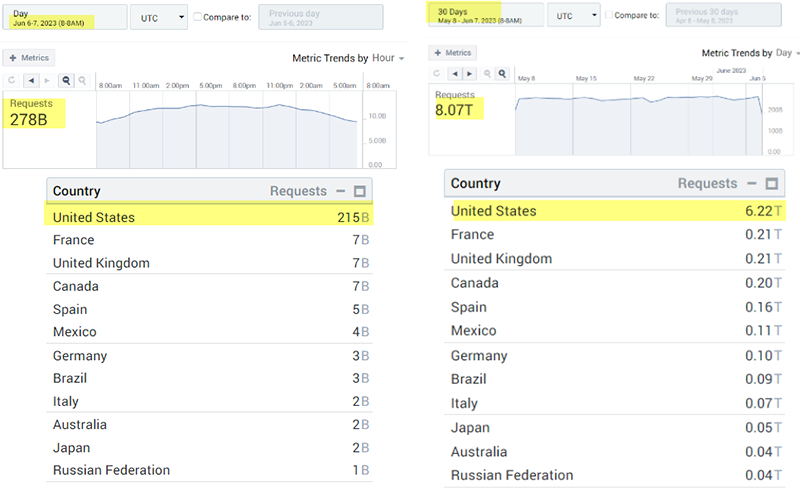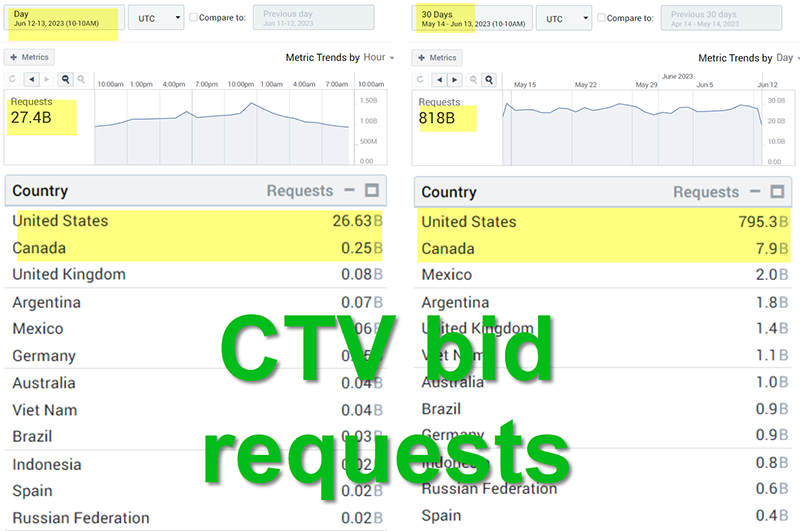It’s time for advertisers to challenge their ad buyers about programmatic ads, because the research shows the numbers do not add up. Solving the problem involves asking some hard questions, explains Dr Augustine Fou, the ad fraud investigator.
Advertisers, it’s time to challenge your ad buyers and your own assumptions about programmatic ads. Here are some numbers to help you gut check what you are buying through programmatic channels.
Let’s start by thinking of the following questions:
- How many humans are there on earth?
- How many have high speed internet or even just basic internet access?
- How many have smartphones?
Recent stats tell us there's just under 8 billion humans on earth. There's "4.9 billion active internet users worldwide (62% of the population)." (Jan 12, 2023). "In 2023, the current number of smartphone users in the world is 6.92 billion, meaning 86.29% of the world's population owns a smartphone." (March 2023). I don't think nearly 90% of humans have a smartphone (especially if they don’t have internet access or basic food and water); it's more likely that in affluent countries, consumers have more than 1 smartphone each. The population of the U.S. is about 332 million. These stats companies include kids and babies, who certainly can't buy smartphones or make monthly payments on wireless plans themselves. But even assuming the "6.92 billion smartphone users" number above is correct, what follows is still absurdly absurd.
Not enough humans in all of human history
Now, let’s think about your assumptions about digital media. The way digital advertising is supposed to work is when a human visits a website, the page loads and then the ads load. But what if that user was not a human, but a piece of software known as a bot that repeatedly loads the webpages to cause vast numbers of ads to load or a mobile emulator that loads and runs mobile games and flashlight apps continuously 24/7? Humans’ usage of digital media (yellow and green lines) in the chart below have all plateaued since 2013. But yet, the blue line – digital ad spending in the U.S. – continued shooting upward. The gap between ad spending and the number of digital ads is at its widest now. The number of ad impressions cannot be explained by humans’ usage of the Internet, social, and mobile, even with parallel consumption; it’s been out of whack for the last decade. The numbers just don’t add up if you’re actually seeking to show ads to humans when they are consuming media.

Bid request firehose
To make the absurdity more concrete, let’s take a look at the programmatic bid request firehose. Bid requests are sent when each ad opportunity comes up. For example, when a page loads, each ad slot calls out for bids, such as “who wants to bid on me?” In collaboration with AIDEM and Giovanni Sollazzo, we looked at some quantities in the programmatic bid "firehose". In one 24-hour period, we see:
- 278 billion bid requests (about 40X the 6.92 billion smartphone users globally).
- 215 billion bid requests come from the U.S. (about 647X the population of the U.S.).
The left side of the chart below shows daily numbers. The right side shows monthly numbers: 8.1 trillion worldwide, and 6.2 trillion in the U.S. Do these numbers seem reasonable to you? Do they pass a simple gut check?

Keep in mind the above only represents the ads bought and sold through programmatic channels. That means there are vast quantities of search ads on Google, video ads on YouTube, ads on Facebook, Instagram, and WhatsApp, TikTok ads, etc. that run in addition to these programmatic display, video, and connected TV ads.
CTV gut check
I won’t belabor the point much further, but I will show you what bid request quantities look like in CTV (“connected TV”), the darling of media buyers today. At some of the highest CPM prices in all of digital advertising, CTV is the darling of fraudsters too!
- 27 billion bid requests per day (26.6 billion from the U.S.)
- 818 billion bid requests per month (795 billion from the U.S.)
The number of connected TVs is estimated to be around 60 million (out of the 330 million people in the U.S., one in five people have connected TVs). The numbers above imply 450 bid requests per day per CTV, and 13,633 per month. Seems reasonable?

Consider the following data from TVision. If humans are spending their time streaming on Netflix, YouTube, Amazon Prime Video, Disney+, AppleTV, HBO Max, and Hulu, how much time would they have to stream on connected TV devices and apps outside of those (which is where the majority of the programmatic CTV inventory comes from)?

No fraud in CTV because it’s impossible
To this day, I am hearing CTV ad buyers claim that there’s “no fraud in CTV because it’s impossible.” You’d think that I’d think that that’s absurd. But would you believe that statement is true? It IS true if you consider only real media sellers. The opposite is true too: nearly 100% of the CTV bid requests seen in the programmatic firehose are suspect or outright fraud. That’s right. All 19 CTV fraud cases in the last two years have been faked bid requests. None of the ads ever ran, let alone ran on a TV. The Grindr mobile app (and other mobile apps) are sending bid requests pretending to be connected TV so they can earn the higher CPMs. Smart refrigerators were also fabricating fake CTV bid requests. Python scripts and javascript code in ad slots were generating more than 12 billion fake CTV bid requests per day. Using round numbers, these 12 billion faked CTV bid requests account for roughly half of the 26 billion CTV bid requests observed daily in the U.S. At this time, there’s no detection technology that can verify the bid request originated from a real connected TV or directly detect the ad ran on a TV. The static image pixels currently in use for fraud detection in CTV can be invoked by any party at any time. For example, it is trivial to invoke the Complete.gif tracking pixel to make it appear the video ad was watched to completion even if no ad ever ran.
So what?
Hopefully the stroll through the programmatic bid request firehose above gave you a frightening glimpse into what is supposedly being bought and sold through programmatic channels. Hopefully the quantities gave you a chance to gut check your assumptions with some common sense. What should advertisers do from here on out?
- Ask the ad sellers how it is possible that they are offering to sell such vast quantities of ad impressions, especially on CTV
- As if the ad sellers are bundling audience extension – e.g. where ads are run on sites and apps, not on TVs – but still selling it at CTV prices
- Consider buying direct from real media sellers (hint: they still have unsold inventory). There is no free lunch and most low-cost CTV ads are not real.
- Do the hard work of measuring for incrementality of business outcomes; this will tell you if your programmatic ads are actually driving more business outcomes than in the absence of those ads.

